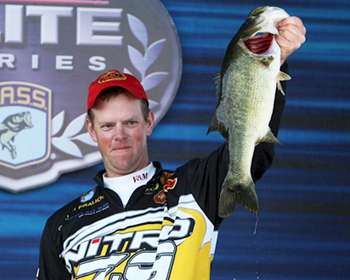
The dog days of summer are upon us, and while high water temperatures combined with low flow can make bass sluggish, even the slightest injection of life can make them active once again.
South Dakota pro Jami Fralick knows this all too well. Growing up, whenever there was a slight dip in the summertime temperatures, he suddenly developed a mysterious "cold" that caused him to miss school — fishing fever, they called it. But no matter where you live, if you have any flexibility in your schedule at all, it can pay off tremendously to hit the water whenever the temperatures dip.
"At home, if you get the those temperature drops in the summertime, it usually really turns them on," Fralick says. He's not necessarily talking about monstrous changes in conditions. When it's been in the 90s for weeks and suddenly there's a 50-degree night or two, that can be enough to trigger the feeding frenzy.
"It's something that can be extremely small, like a degree or two," he adds. "If they're used to 82-degree water and it drops down to 80 and you get a cloudy day, it triggers them to bite."
He doesn't necessarily abandon the areas where he knows they live. While there's been a sudden injection of energy into otherwise listless bass, it's not enough to make them swim miles up or down the lake in search of new cover or feeding opportunities. "They have an area that they want to be in — that little 50- to 60-yard stretch — and they'll stay there," he says. "And when there's one bass, there are usually several."
The absolute best days are when the cooling temperatures are accompanied by cloud cover. That causes the bass to be less cautious and to roam within their preferred area a bit more. That's when Fralick gets out a spinnerbait or Rat-L-Trap and starts covering water, particularly along a grass flat or grassline. Putting the trolling motor on high and making as many casts as he can, he'll often experience lights-out fishing that rivals the action of the prespawn or spawn periods.
Oftentimes they'll be every bit as shallow, Fralick submits. "Where I'm from, fish don't go that deep," he explains. "Very seldom do you have to fish over 10 feet deep; usually they'll stay in 2 to 4 feet of water. If it's cloudy when it cools off, those shallow fish will stay shallow, and they'll bite better."
The situation is complicated a bit when the sun stays out. "Even though the temperature might have dropped, you're still going to have to flip bushes or flip cattails," he says. The bass will be tighter to cover, but the "mush bites" of a week ago will be transformed into arm-jarring slams.
Even within a single lake there can be temperature differences, depending on light penetration, current flow and sun exposure. Fralick believes anglers who don't turn on their temperature gauges in late summer are missing a prime opportunity to clean up on one of the best bites of the year.





